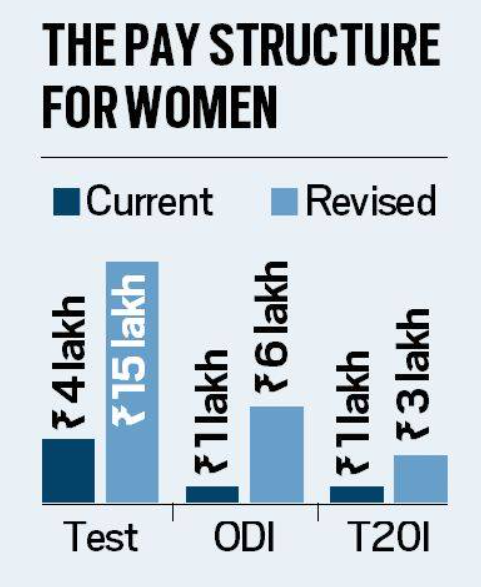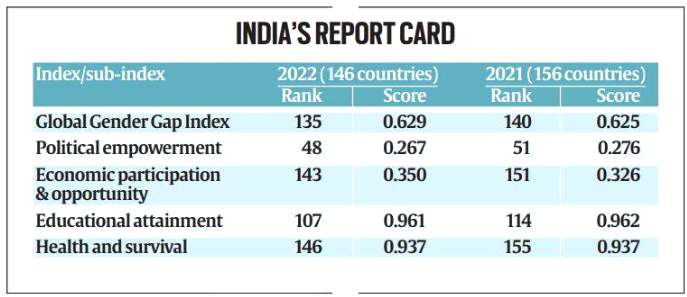Social Issues
Pay Parity in Cricket
- 29 Oct 2022
- 8 min read
For Prelims: Countries & Sports with Equal Pay Parity, Global Gender Gap Index
For Mains: Challenges in bringing equal pay in sports, Key Highlights of Global Gender Gap Index, Government’s Initiatives to Reduce Gender Gap
Why in News?
- Recently, the Board of Control for Cricket in India (BCCI) announced a “pay equity policy”, saying that its centrally-contracted men and women players would get the same match fees.
- The step is a significant move towards bringing gender pay parity as, according to Global Gender Gap Index 2022, at the current rate of progress, it will take 132 years to reach full parity.
What do we know about the Increase in Women Player’s Fee?
- The women players will now get Rs 15 lakh per Test match, Rs 6 lakh for a One-Day International (ODI), and Rs 3 lakh for a T20 International. Till now, they were paid Rs 1 lakh for a white-ball match, and Rs 4 lakh for a Test.
- The annual retainership for women cricketers remains the same — Rs 50 lakh for Grade A, Rs 30 lakh for Grade B and Rs 10 lakh for Grade C.
- The men, who play more games, are paid Rs 1-7 crore, depending on their grade.
Has any Other Country also Implemented Equal Pay in Sports?
- India has become only the second country in international cricket to implement equal pay.
- New Zealand Cricket (NZC), in 2022, had struck a deal with the country's players' association, which enabled the women cricketers to earn as much as the male players.
- This comes four months after the United States’ women’s national footballers won the six-year-long battle with their federation to secure equal compensation.
- Tennis has made moves to increase equal pay between their male and female players, and today all four major tennis tournaments (Australian Open, Roland Garros, Wimbledon and US Open) offer equal prize money.
What are the Challenges in Bringing Gender Pay Parity in Sports?
- Revenue Generation:
- The argument is that the returns generated by male players are higher than what women generate.
- While assessing the monetary benefits in sports, a few things are considered, including endorsements, sports merchandising and ticket sales, among others. However, this is based on the viewership and fanbase, which is, in turn, influenced by the androcentric nature of sports.
- Women’s entry into sports happened much later than men due to societal restrictions. This has resulted in a lower ‘entertainment value’ of women’s sport.
- Differential Performance:
- This argument states that since men are ‘stronger’ and can perform better in sports than women, they should be paid a higher amount.
- In professional tennis, men play five sets per match and women play three sets per match, a rule based on the assumption that women are physically weaker than men.
- Despite women’s demonstrated willingness and capability to play five sets, decision-makers (who were mostly men) believed that the quality of the game would deteriorate if women played five sets.
- Representation Issues:
- The weak representation of women in sports governance structures is also a cause of the persistence of the pay gap in the sport industry. Female representation in some governance structures has improved, but this has only happened recently. Further, most of the governing bodies still need a stronger push to enhance female membership.
What is the Key Revelation of Global Gender Gap Index 2022?
- About:
- Global Gender Gap Index benchmarks countries on their progress towards gender parity in four Key dimensions with Sub Metrices namely:
- Economic Participation and Opportunity, Educational Attainment, Health and Survival, Political Empowerment.
- Global Gender Gap Index benchmarks countries on their progress towards gender parity in four Key dimensions with Sub Metrices namely:
- India’s performance:
- India has been ranked at 135, out of a total of 146 countries.
- India’s overall score has improved from 0.625 (in 2021) to 0.629, which is its seventh-highest score in the last 16 years.
- In 2021, India was ranked 140 out of 156 countries.
- Economic Participation and Opportunity (Percentage of women in labour force, Wage Equality for similar work, Earned income):
- India ranks a lowly 143 out of the 146 countries in contention even though its score has improved over 2021 from 0.326 to 0.350.
- In 2021, India was pegged at 151 out of the 156 countries.
- India’s score is much lower than the global average, and only Iran, Pakistan and Afghanistan are behind India on this metric.
What are the Indian Initiatives to reduce Gender Gap in Social, Economic and Political Life?
- Economic Participation and Health and Survival:
- Political Reservation:
- Government has reserved 33% of the seats in Panchayati Raj Institutions for women.
- Capacity Building of Elected Women Representatives:
- It is conducted with a view to empowering women to participate effectively in the governance processes.
UPSC Civil Services Examination, Previous Year Questions
Prelims:
Q. Which of the following gives ‘Global Gender Gap Index’ ranking to the countries of the world? (2017)
(a) World Economic Forum
(b) UN Human Rights Council
(c) UN Women
(d) World Health Organization
Ans: (a)
Exp:
- The Global Gender Gap Report is published by the World Economic Forum. The report’s Gender Gap Index, which is designed to measure gender equality ranks countries, according to the calculated gender gap between women and men in four key areas: health, education, economy and politics to gauge the state of gender equality in a country.
- The Global Gender Gap Report 2021 benchmarks 156 countries on their progress towards gender parity across four thematic dimensions: Economic Participation and Opportunity; Educational Attainment, Health and Survival, and Political Empowerment. In addition, this year’s edition studied skills gender gaps related to Artificial Intelligence (AI).
- India ranks 140th in WEF Gender Gap Index-2021.
- Therefore, option (a) is the correct answer.
Mains:
- Q. Can the vicious cycle of gender inequality, poverty and malnutrition be broken through microfinancing of women SHGs? Explain with examples. (2021)
- Q. How does patriarchy impact the position of middle-class working women in India? (2014)








